Field Measurement and Evaluation of the Passive and Active Solar Heating Systems for Residential Building Based on the Qinghai-Tibetan Plateau Case
Abstract
1. Introduction
2. Object of the Study
3. Methodology
3.1. Heating Strategies
3.2. Measuring Locations
3.3. Evaluation Criterion
4. Results and Analyses
4.1. Reference Condition
4.2. Passive Solar Heating Condition
4.3. Active Solar Heating Condition
5. Discussion
6. Conclusions
Acknowledgments
Author Contributions
Conflicts of Interest
References
- Nejat, P.; Jomehzadeh, F.; Taheri, M.M.; Gohari, M.; Majid, M.Z.A. A Global Review of Energy Consumption, CO2 Emissions and Policy in the Residential Sector (with an Overview of the Top Ten CO2 Emitting Countries). Renew. Sustain. Energy Rev. 2015, 43, 843–862. [Google Scholar] [CrossRef]
- Xu, F.; Xie, N.; Zhou, J.; Yin, K.; Wang, B. Study on Developing Status and Appropriate Technologies Analysis of Green Residential Buildings in Hunan Province. Energy Procedia 2017, 121, 150–157. [Google Scholar] [CrossRef]
- Liu, Z.; Xu, W.; Zhai, X.; Qian, C.; Chen, X. Feasibility and Performance Study of the Hybrid Ground-Source Heat Pump System for One Office Building in Chinese Heating Dominated Areas. Renew. Energy 2017, 101, 1131–1140. [Google Scholar] [CrossRef]
- Liu, Z.; Xu, W.; Qian, C.; Chen, X.; Jin, G. Investigation on the Feasibility and Performance of Ground Source Heat Pump (GSHP) in Three Cities in Cold Climate Zone, China. Renew. Energy 2015, 84, 89–96. [Google Scholar] [CrossRef]
- Zhao, D.; Ji, J.; Yu, H.; Wei, W.; Zheng, H. Numerical and Experimental Study of a Combined Solar Chinese Kang and Solar Air Heating System Based on Qinghai Demonstration Building. Energy Build. 2017, 143, 61–70. [Google Scholar] [CrossRef]
- Zhou, X.; Wang, F.; Fan, J.; Ochieng, R.M. Performance of Solar Chimney Power plant in Qinghai-Tibet Plateau. Renew. Sustain. Energy Rev. 2010, 14, 2249–2255. [Google Scholar] [CrossRef]
- Xia, Y.; Xia, K.; Shi, Y. Eco-Sustainable Architecture (ESA); Architecture & Building Press: Beijing, China, 2001; pp. 23–52. [Google Scholar]
- Zou, B.; Dong, J.; Yao, Y.; Jiang, Y. An Experimental Investigation on a Small-Sized Parabolic trough Solar Collector for Water Heating in Cold Areas. Appl. Energy 2016, 163, 396–407. [Google Scholar] [CrossRef]
- Lomas, K.J. The UK Applicability Study: An Evaluation of Thermal Simulation Programs for Passive Solar House Design. Build. Environ. 1996, 31, 197–206. [Google Scholar] [CrossRef]
- Liu, Z.; Li, H.; Liu, K.; Yu, H.; Cheng, K. Design of High-Performance Water-in-Glass Evacuated Tube Solar Water Heaters by a High-Throughput Screening Based on Machine Learning: A Combined Modeling and Experimental Study. Sol. Energy 2017, 142, 61–67. [Google Scholar] [CrossRef]
- Li, E.; Liu, J.P.; Yang, L. Research on the Passive Design Optimization of Direct Solar Gain House for Residential Buildings in Lhasa. Ind. Constr. 2012, 42, 27–32. [Google Scholar]
- Wang, W.; Tian, Z.; Ding, Y. Investigation on the Influencing Factors of Energy Consumption and Thermal Comfort for a Passive Solar House with Water Thermal Storage Wall. Energy Build. 2013, 64, 218–223. [Google Scholar] [CrossRef]
- Llovera, J.; Potau, X.; Medrano, M.; Cabeza, L.F. Design and Performance of Energy-Efficient Solar Residential House in Andorra. Appl. Energy 2011, 88, 1343–1353. [Google Scholar] [CrossRef]
- Shan, M.; Yu, T.; Yang, X. Assessment of an Integrated Active Solar and Air-Source Heat Pump Water Heating System Operated within a Passive House in a Cold Climate Zone. Renew. Energy 2016, 87, 1059–1066. [Google Scholar] [CrossRef]
- Rekstad, J.; Meir, M.; Murtnes, E.; Dursun, A. A Comparison of the Energy Consumption in Two Passive Houses, One with a Solar Heating System and One with an Air—Water Heat Pump. Energy Build. 2015, 96, 149–161. [Google Scholar] [CrossRef]
- Zhang, X.F.; Niu, S.-W.; Luo, G.-H.; Yang, L.-N. The Heating Effect of the Additional Solar House to Classroom in the Cold Region—A Case Study of an Elementary School. Energy Procedia 2012, 14, 1193–1198. [Google Scholar]
- Tian, Z.; Perers, B.; Furbo, S.; Fan, J. Annual Measured and Simulated Thermal Performance Analysis of a Hybrid Solar District Heating Plant with Flat Plate Collectors and Parabolic trough Collectors in Series. Appl. Energy 2017, 205, 417–427. [Google Scholar] [CrossRef]
- Chang, H.; Liu, Y.; Shen, J.; Xiang, C.; He, S.; Wan, Z.; Jiang, M.; Duan, C.; Shu, S. Experimental Study on Comprehensive Utilization of Solar Energy and Energy Balance in an Integrated Solar House. Energy Convers. Manag. 2015, 105, 967–976. [Google Scholar] [CrossRef]
- Zhai, X.Q.; Dai, Y.J.; Wang, R.Z. Comparison of Heating and Natural Ventilation in a Solar House Induced by Two Roof Solar Collectors. Appl. Therm. Eng. 2005, 25, 741–757. [Google Scholar] [CrossRef]
- Zhu, J.; Chen, B. Experimental Study on Thermal Response of Passive Solar House with Color Changed. Renew. Energy 2015, 73, 55–61. [Google Scholar] [CrossRef]
- Miller, W.; Buys, L.; Bell, J. Performance Evaluation of Eight Contemporary Passive Solar Homes in Subtropical Australia. Build. Environ. 2012, 56, 57–68. [Google Scholar] [CrossRef]
- Liu, C.; Li, H.; Cao, G. Quick Estimation Model for the Concentration of Indoor Airborne Culturable Bacteria: An Application of Machine Learning. Int. J. Environ. Res. Public Health 2017, 14, 857. [Google Scholar]
- Thalfeldt, M.; Pikas, E.; Kurnitski, J.; Voll, H. Facade Design Principles for Nearly Zero Energy Buildings in a Cold Climate. Energy Build. 2013, 67, 309–321. [Google Scholar] [CrossRef]
- Stevanović, S. Parametric Study of a Cost-Optimal, Energy Efficient Office Building in Serbia. Energy 2016, 117, 492–505. [Google Scholar] [CrossRef]
- Yu, H.; Dang, J.; Ma, W.; Zhan, P.; Sun, Z. Technical Specification for Passive Solar Heating in Qinghai Province, (DB63/T 1527-2016); Standard Press: Qinghai, China, 2017. [Google Scholar]
- Liu, Y.; Ma, J.; Zhou, G.; Zhang, C.; Wan, W. Performance of a Solar Air Composite Heat Source Heat Pump System. Renew. Energy 2016, 87, 1053–1058. [Google Scholar] [CrossRef]
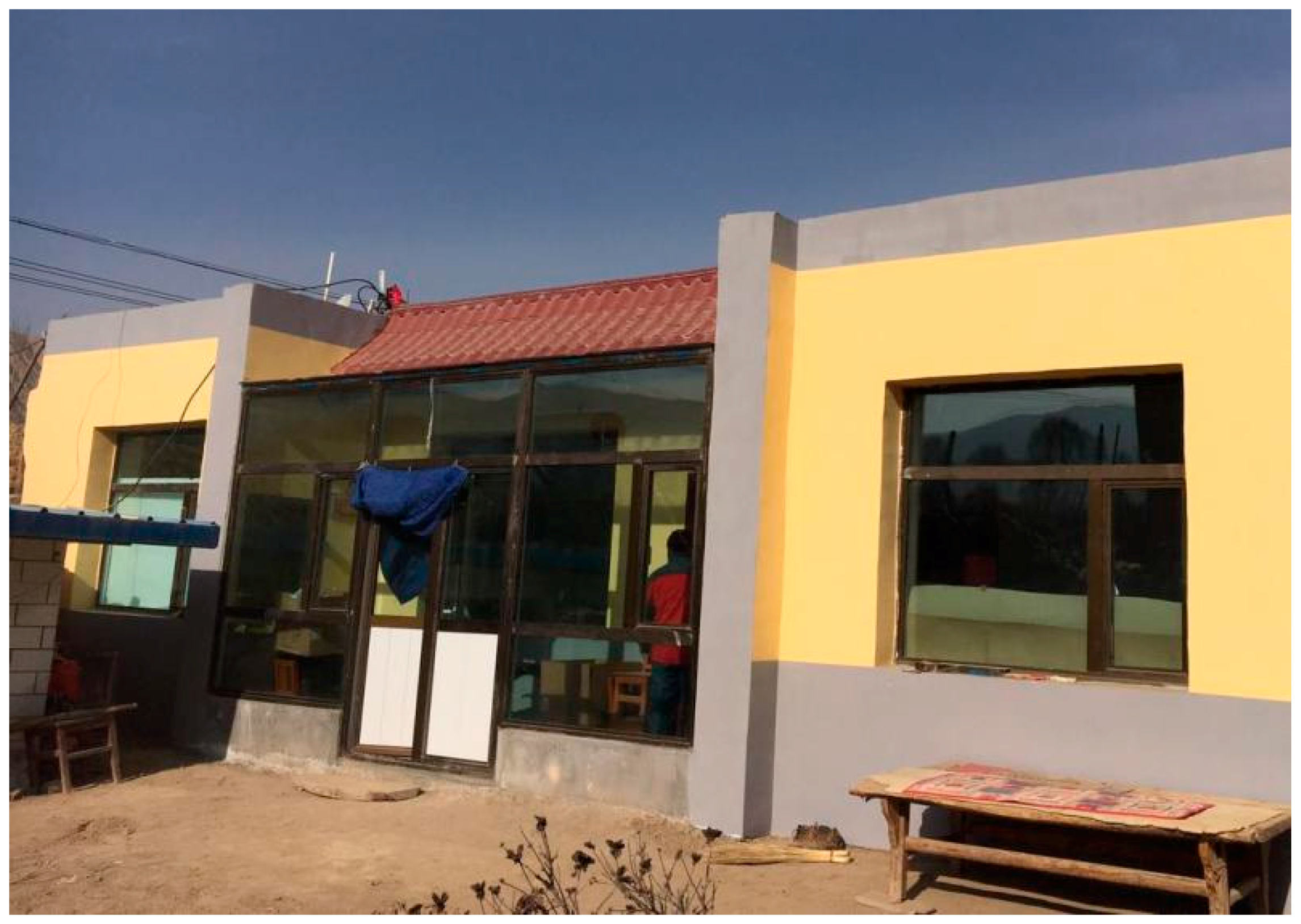
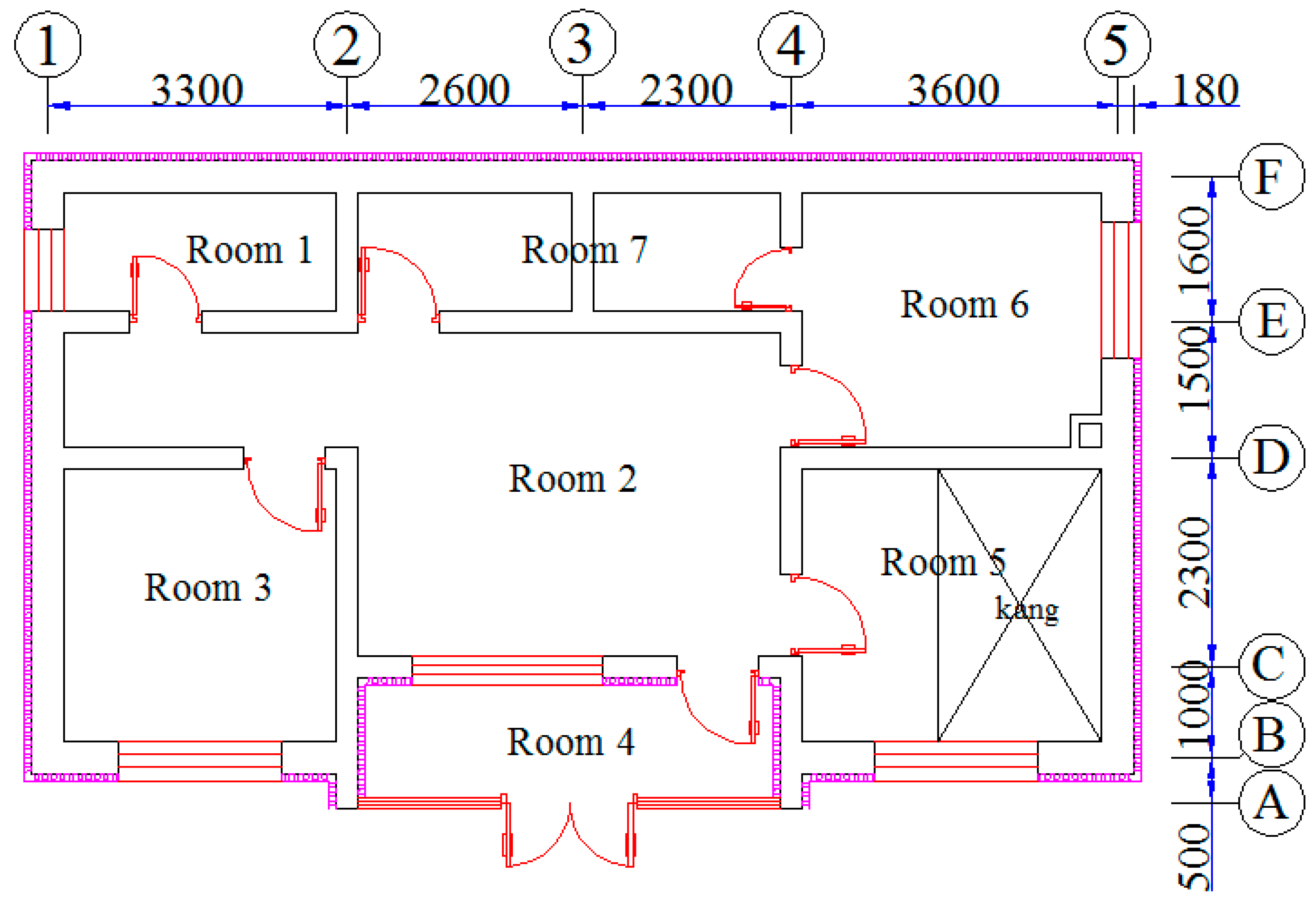
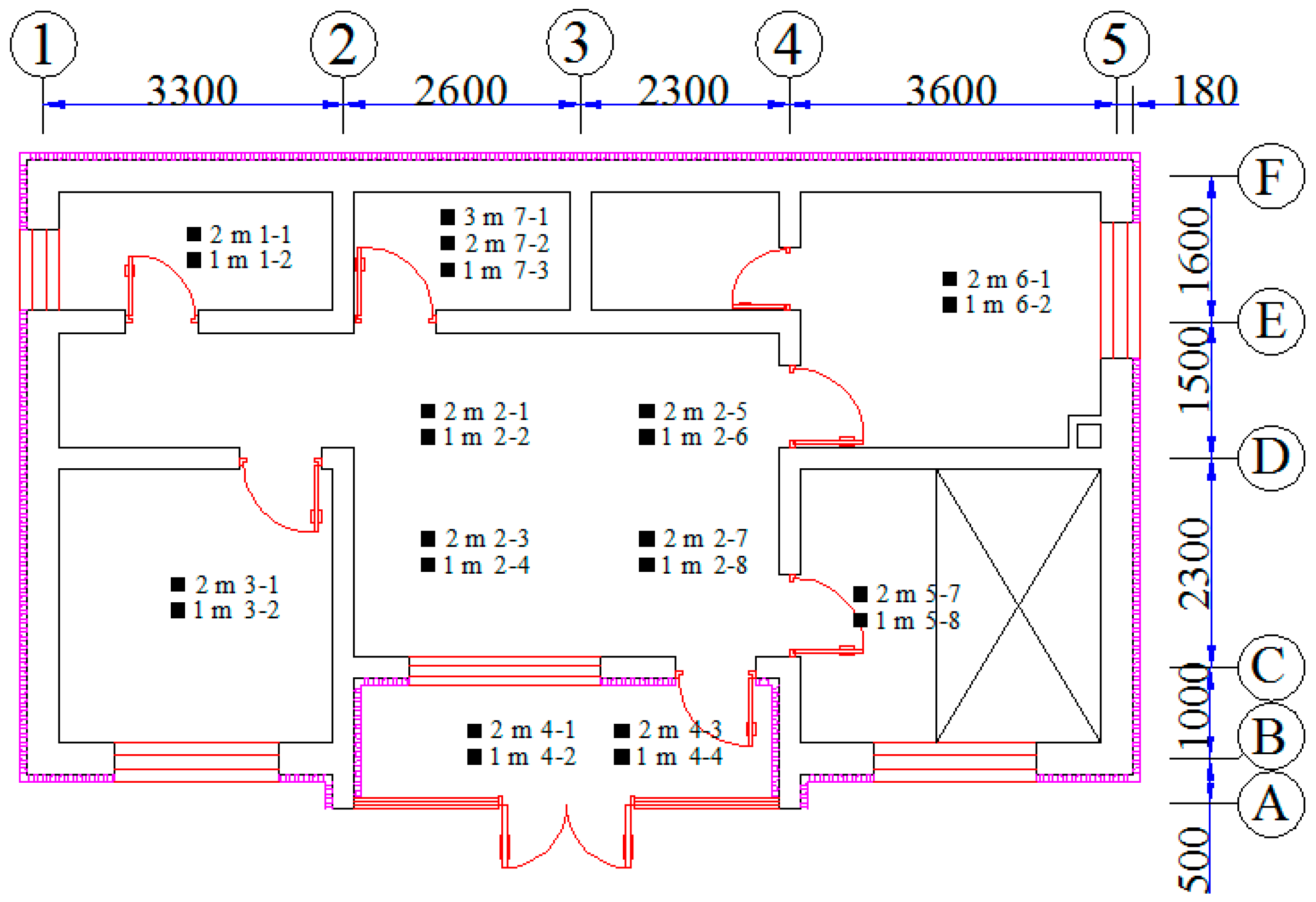
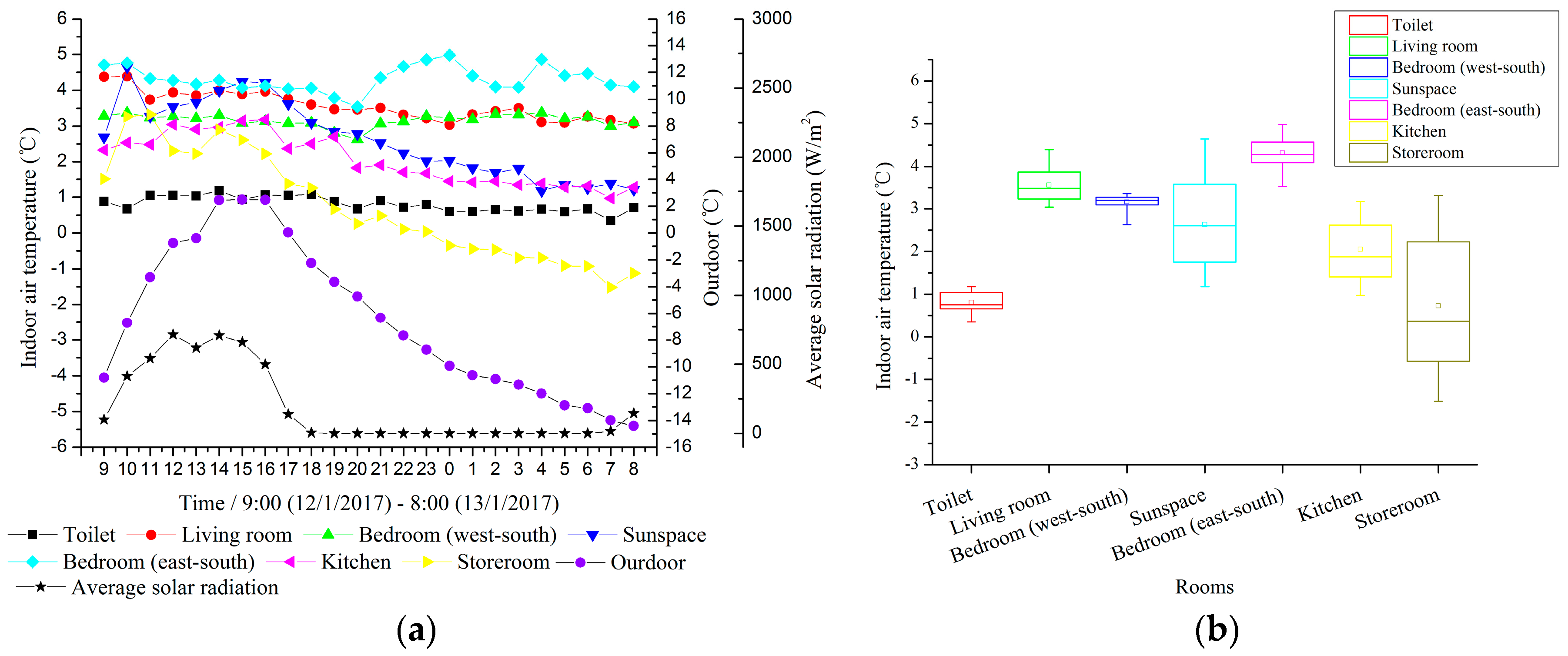
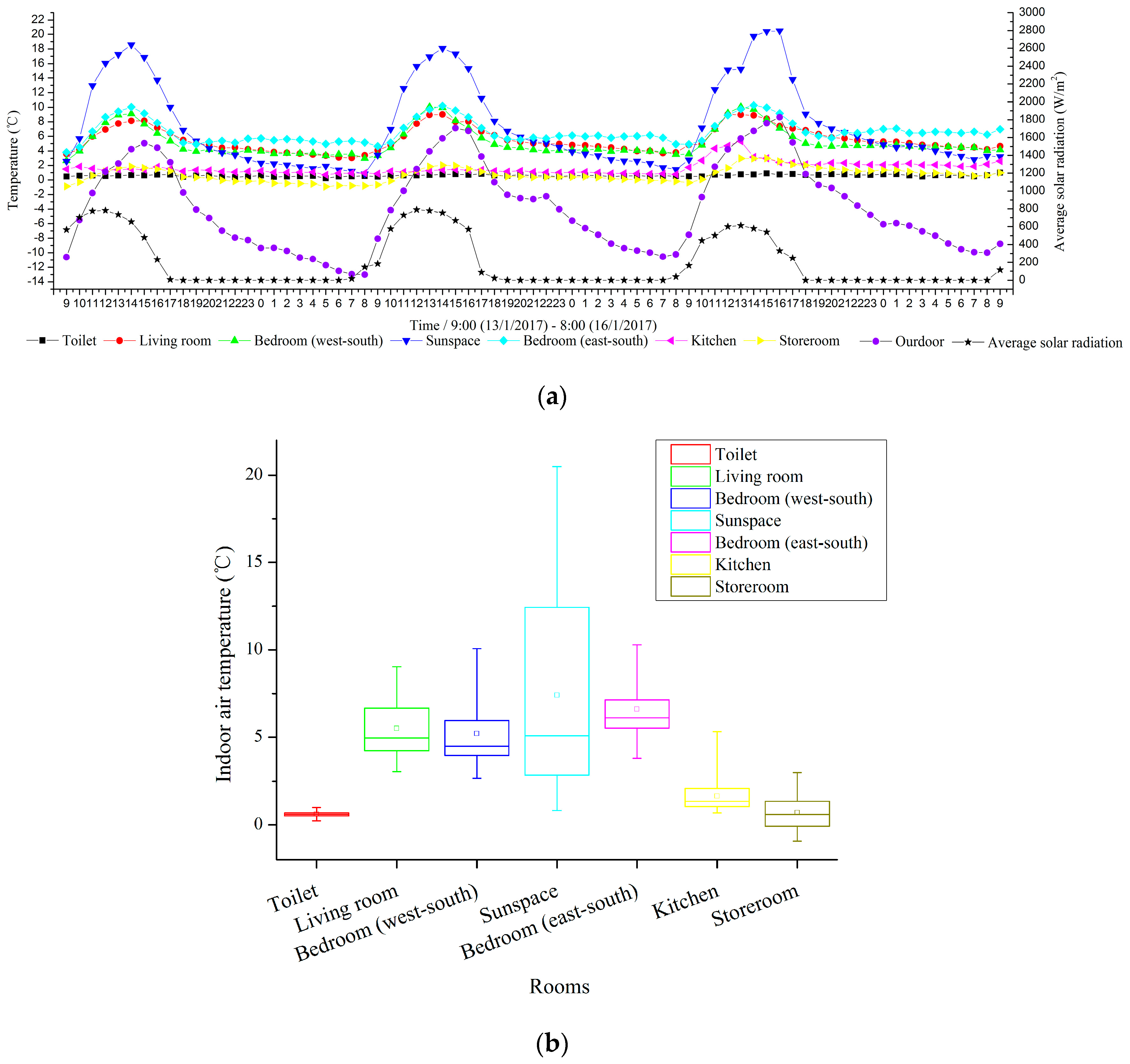

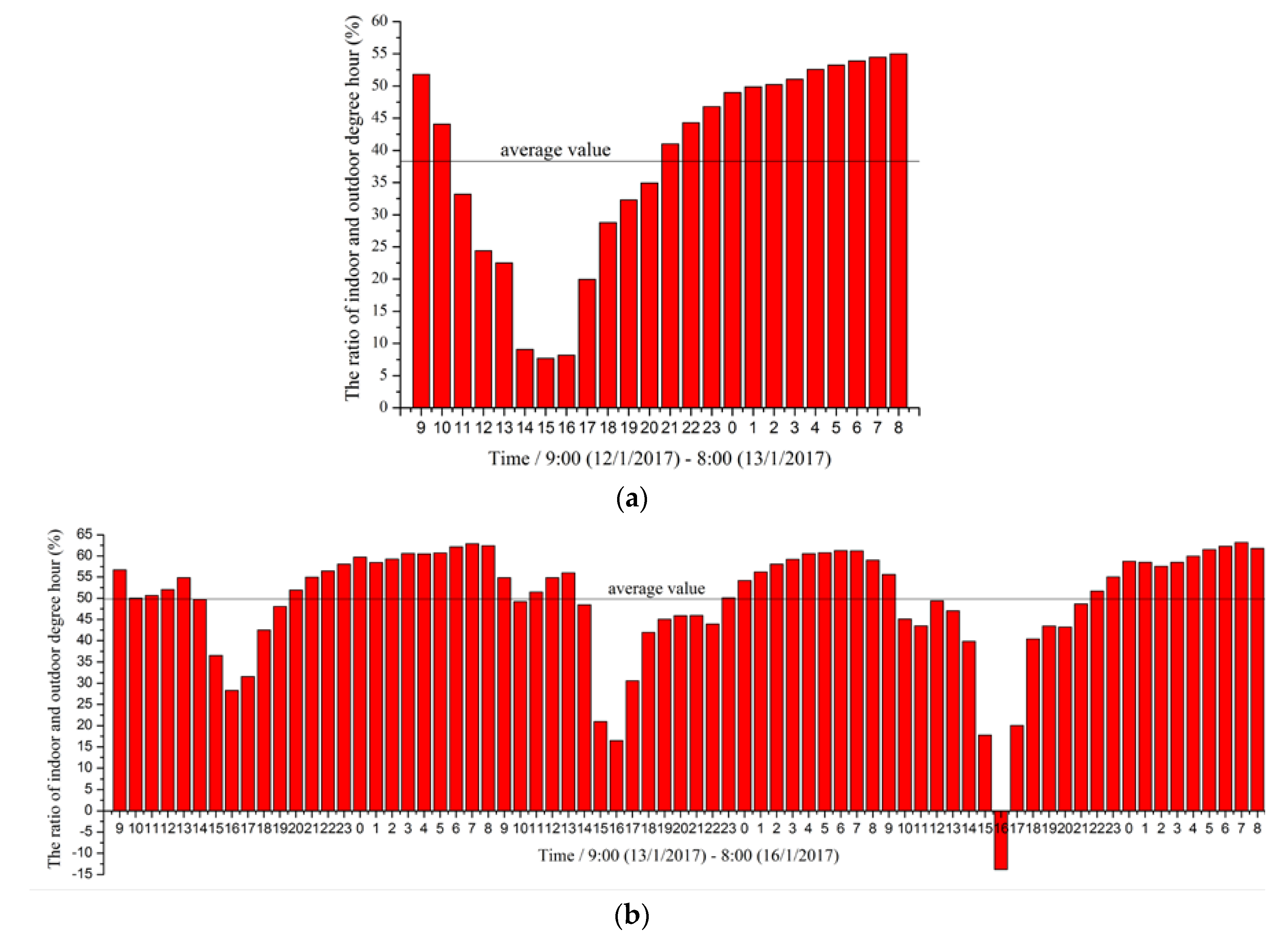
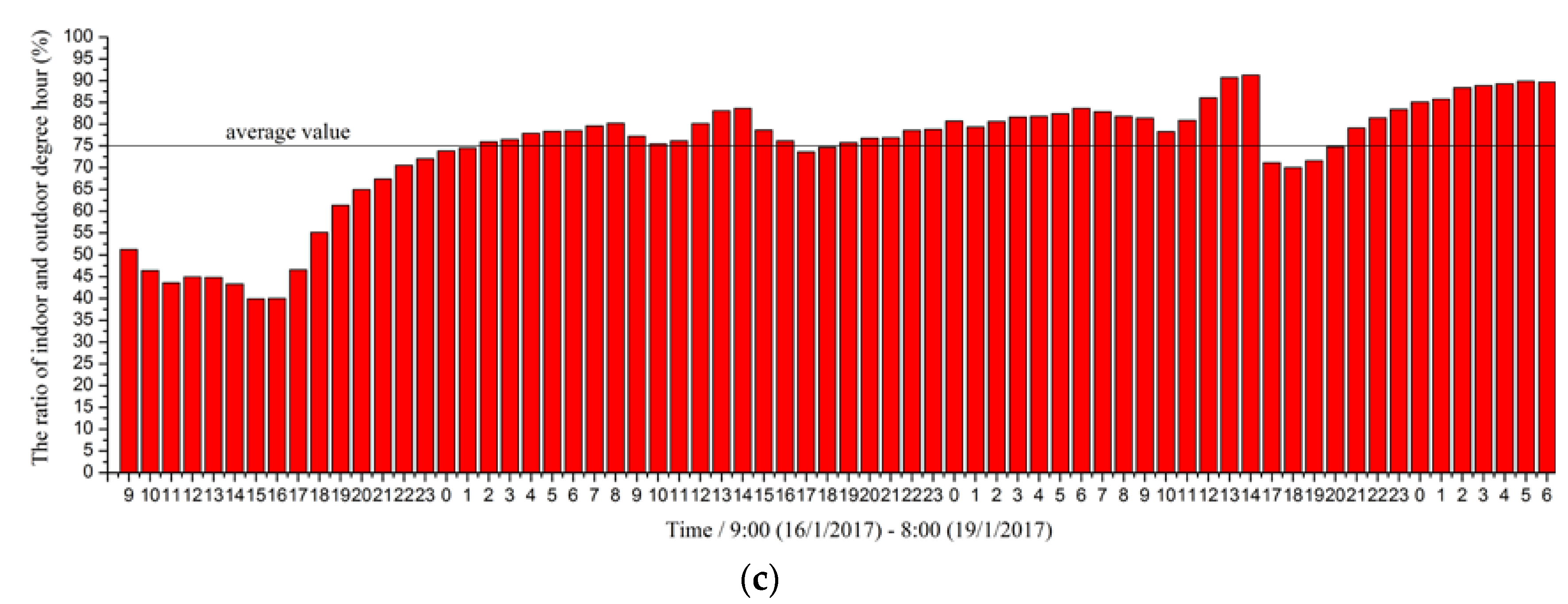
| WWRs | |
| South direction | 0.33 |
| North direction | 0 |
| East direction | 0.11 |
| West direction | 0.04 |
| Roof | 0 |
| Area of external wall (including windows) | |
| South direction | 42.70 m2 |
| North direction | 39.37 m2 |
| East direction | 22.91 m2 |
| West direction | 22.91 m2 |
| Roof | 84.15 m2 |
| Area of external window | |
| South direction | 14.10 m2 |
| North direction | 0 m2 |
| East direction | 2.55 m2 |
| West direction | 0.81 m2 |
| Building information | |
| Total floor area of building | 84.15 m2 |
| Volume of building | 283.73 m3 |
| Total area of external wall (including windows) | 212.04 m2 |
| Shape coefficient | 0.75 |
| Integrated shading coefficient | SC = 0.68 |
| Solar heat gain coefficient | SHGC = 0.78 |
| Solar radiation correction coefficient of door and window | Cmci = 0.41 |
| Total heat transfer coefficient | |
| External wall | 0.29 W/(m2·K) |
| Opaque section of roof | 0.15 W/(m2·K) |
| External window | 2.20 W/(m2·K) |
| Ground | 0.15 W/(m2·K) |
| External door | 1.70 W/(m2·K) |
| Rooms | Points | Locations |
|---|---|---|
| Toilet (Room 1) | 1–1 | 2 m from the ground of the room center |
| 1–2 | 1 m from the ground of the room center | |
| Living room (Room 2) | 2–1 | 2 m from the ground (north-west) |
| 2–2 | 1 m from the ground (north-west) | |
| 2–3 | 2 m from the ground (south-west) | |
| 2–4 | 1 m from the ground (south-west) | |
| 2–5 | 2 m from the ground (north-east) | |
| 2–6 | 1 m from the ground (north-east) | |
| 2–7 | 2 m from the ground (south-east) | |
| 2–8 | 1 m from the ground (south-east) | |
| Bedroom (Room 3) | 3–1 | 2 m from the ground of the room center |
| 3–2 | 1 m from the ground of the room center | |
| Sunspace (Room 4) | 4–1 | 2 m from the ground (west) |
| 4–2 | 1 m from the ground (west) | |
| 4–3 | 2 m from the ground (east) | |
| 4–4 | 1 m from the ground (east) | |
| Bedroom (Room 5) | 5–1 | 2 m from the ground of the room center |
| 5–2 | 1 m from the ground of the room center | |
| Kitchen (Room 6) | 6–1 | 2 m from the ground of the room center |
| 6–2 | 1 m from the ground of the room center | |
| Storage room (Room 7) | 7–1 | 3 m from the ground of the room center (west) |
| 7–2 | 2 m from the ground of the room center (west) | |
| 7–3 | 1 m from the ground of the room center (west) |
| Measuring Devices | Model | Range | Resolution | Accuracy | Manufacturers |
|---|---|---|---|---|---|
| Thermocouple | T-Type | −200–320 °C | 0.2 °C | 0.4% | PTR (China) |
| Pyranometer | Survey100 | 0–1500 W/m2 | 0.1 W/m2 | 0.5% | Seaward (Britain) |
| Temperature Data Logger | LR8401-21 | −120–350 °C | 0.1 °C | 0.5% | HIOKI (Japan) |
| Conditions | Toilet (°C) | Living Room (°C) | Bedroom (°C) | Sunspace (°C) | Bedroom (°C) | Kitchen (°C) | Storage Room (°C) |
|---|---|---|---|---|---|---|---|
| Reference | 0.8 | 3.6 | 3.2 | 2.6 | 4.3 | 2.1 | 0.7 |
| Passive solar heating | 0.6 | 5.5 | 5.2 | 7.4 | 6.6 | 1.6 | 0.7 |
| Active solar heating | 4.9 | 13.9 | 12.2 | 9.3 | 11.1 | 4.6 | 2.0 |
© 2017 by the authors. Licensee MDPI, Basel, Switzerland. This article is an open access article distributed under the terms and conditions of the Creative Commons Attribution (CC BY) license (http://creativecommons.org/licenses/by/4.0/).
Share and Cite
Liu, Z.; Wu, D.; Jiang, M.; Yu, H.; Ma, W. Field Measurement and Evaluation of the Passive and Active Solar Heating Systems for Residential Building Based on the Qinghai-Tibetan Plateau Case. Energies 2017, 10, 1706. https://doi.org/10.3390/en10111706
Liu Z, Wu D, Jiang M, Yu H, Ma W. Field Measurement and Evaluation of the Passive and Active Solar Heating Systems for Residential Building Based on the Qinghai-Tibetan Plateau Case. Energies. 2017; 10(11):1706. https://doi.org/10.3390/en10111706
Chicago/Turabian StyleLiu, Zhijian, Di Wu, Miao Jiang, Hancheng Yu, and Wensheng Ma. 2017. "Field Measurement and Evaluation of the Passive and Active Solar Heating Systems for Residential Building Based on the Qinghai-Tibetan Plateau Case" Energies 10, no. 11: 1706. https://doi.org/10.3390/en10111706
APA StyleLiu, Z., Wu, D., Jiang, M., Yu, H., & Ma, W. (2017). Field Measurement and Evaluation of the Passive and Active Solar Heating Systems for Residential Building Based on the Qinghai-Tibetan Plateau Case. Energies, 10(11), 1706. https://doi.org/10.3390/en10111706




